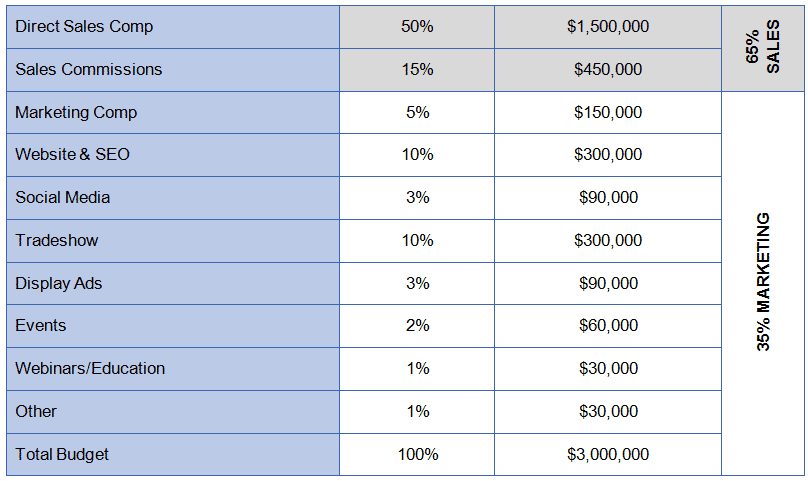How Much Should You Spend on Marketing in 2014?

For years, there has been fervent debate on how much companies should spend on sales and marketing. Entrepreneurs often struggle to find relevant benchmarks for purposes of establishing sales and marketing budgets.
A recent CMO Survey published by the American Marketing Association and Duke University closes the gap with specific benchmarks for both B2B and B2C companies, large and small.
Averages for marketing investment as a percentage of revenue were as follows:
It should be noted that organizations that take part in the survey identify themselves as “marketing companies”, so their investment may be on the high end of the scale.
Other marketing benchmarks relevant to Vistage companies would include:
- The average spend for companies of less than $25 Million in revenue is 11% of sales.
- The average spend for companies of $25-$99 Million is 9% of sales.
- In 2013, the average increase in marketing budget was 6%.
- Companies with zero internet sales average 7% while those with more than 10% internet sales average 13% sales and marketing spend.
- The emphasis of marketing is shifting quickly with legacy marketing spending declining (-3%) while digital marketing spending is increasing 12% with social media spending up 22%.
- 6% of marketing spend is on CRM.
While every business is unique, several trends are emerging that would apply to most organizations:
- Company size alone does not dramatically affect marketing spend (as a percentage). Smaller companies spend more as a percentage of revenue than larger companies.
- Technology is driving massive change and can be a great equalizer for companies trying to compete against larger firms.
- Companies have clearly shifted to investment in digital assets.
- Marketers are able to make a clearer line of site to return on investment and companies are increasing their marketing spending (which may also reflect more confidence in the economy).
When building a marketing plan and corresponding marketing budget, every company must consider several vital questions:
- How does our sales and marketing strategy align with our business goals?
- What is an acceptable return on investment?
- How much should the marketing budget be?
- Where and how should the money be allocated?
In considering these questions, the organization might start with an assessment of existing marketing and sales effectiveness. A useful measure is Selling Expense Productivity Ratio (SEPR), or the amount of new revenue (or margin) that is generated for every dollar of sales and marketing spend. While it may be difficult to measure SEPR vs. other companies, firms should be able to track increases each year which would justify additional spending. In other words, when SEPR is increasing, additional investment may be warranted.
Another way to view the ratio is acquisition cost. Naturally, companies must measure their acquisition cost and find an appropriate equilibrium for their investment. While the attributes of acquisition cost may vary, a simple measure would be selling expense divided by the number of new customers, assuming sales people do not service existing business. In that case, an estimate of the time they spend selling to new customers would need to be calculated.
Acquisition Cost = Selling Costs $3,000,000\New Customers 150 = $20,000 or
SEPR (Margin) = Selling Costs $3,000,000\Lifetime Value of New Margin Dollars $7,000,000 = 43%
It is such calculation of return on marketing investment (ROMI) that is driving activity towards SEO (search engine optimization) and the like where the returns are proving to be much higher than traditional marketing methods.
Companies should recognize that there is a base budget required to protect existing volume, and a different level of spending required generating incremental volume (new business).
Marketing as a function is in the business of improving sales productivity. When crafting a marketing plan and corresponding budget, the marketer must assess how to allocate various activities. Naturally, this allocation will vary from one company to the next. Industries with a direct sales force could easily spend 20-30% of revenue on sales, while online businesses may spend zero.
For a $20 million company, spending 15% of revenue on sales and marketing a marketing budget could be:
In constructing sales and marketing budgets, companies should:
- Ensure sales and marketing is listed on multiple lines on the P&L, so that true costs are not masked or distorted.
- Ensure adequate spending for digital assets including an annual refresh of your website and content.
- Drive search engine optimization
- Develop a sales scorecard and include important measures such as new customer sales, SEPR or acquisition costs, etc.
Category: Customer Engagement Financials
Tags:




This is very, very helpful Marc. Thank you.